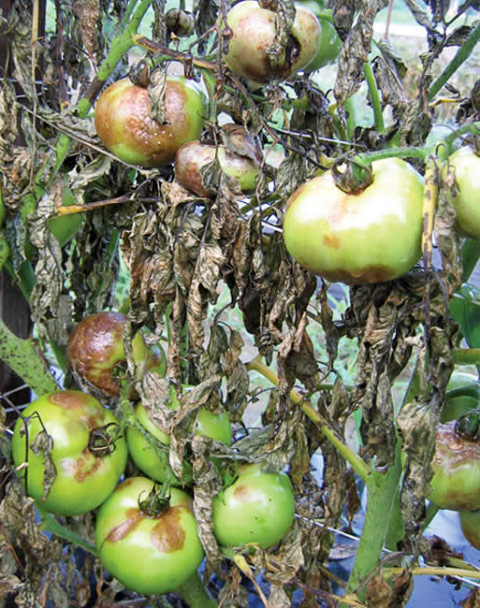Late Blight Q&A
 |
|
Late blight brought heartache to many a northeastern gardener and tomato lover in 2009. Photo by Ruth Hazzard |
The 2009 gardening and farming season will be remembered for its widespread outbreak of late blight, Phytophthora infestans, in tomato and potatoes. Home gardeners and farmers can take steps to prevent this disease from surviving the winter and prepare for a healthy crop next year.
Why was late blight such a serious problem this year?
The late blight fungus spreads fast, rapidly producing spores that travel on wind currents to infect other plants and nearby fields. This year, the disease was reported over a broad portion of the country very early in the season. Infected plants may have been distributed to large local retail stores throughout the Northeast. To make matters worse, cool, damp weather conditions in much of the region were ideal for development and spread of the disease for a period of 6–7 weeks from early June until late July.
How can I prevent late blight from surviving the winter?
The late blight fungus needs live plant tissue to survive. Tomatoes will not carry late blight over the winter because freezing kills the whole plant. Even seeds from fruit that was infected will not carry the pathogen, so you can still use your own seed to start next year’s crop. Late blight will not survive on tomato stakes and cages. Even so, other tomato plant diseases (such as Septoria leaf spot) can overwinter on dead tissue or stakes, so it’s wise to do thorough cleanup of all tomato plant debris.
Potatoes are trickier because infected tubers can carry the pathogen into the next spring if the tubers don’t freeze or decay during the winter (e.g., if left several inches down in the soil at harvest, or in a compost pile that doesn’t fully decompose or freeze). Try to do a thorough job harvesting potatoes, and incorporate any remaining vines and leaves into the soil (the soil environment speeds decay). Composting also works, but be sure to keep the pile heating till plant material is fully decomposed.
What should I do next spring?
Select disease-resistant tomato varieties for at least some of your crop, and use disease-free seed. “Mountain Magic,” “Plum Regal,” and “Legend” are three varieties with resistance or tolerance to late blight. (Note: In 2010, Legend variety seeds are available from Territorial Seed Company. Availability of Mountain Magic and Plum Regal is unknown.) Grow your own tomato transplants or purchase from a reputable grower to ensure a healthy start next season. Inspect all transplants for stem, petiole cankers, or leaf blight before planting.
Don’t save potato tubers as seed to be planted next spring if you had late blight symptoms in your garden this year. Instead, purchase certified disease-free seed from a reputable source (ask your supplier whether their source was inspected for late blight). Check last year’s potato plot and any compost piles for “volunteer” potato plants that might come up. If you do find plants and buried tubers, dig them up and destroy them.
During the growing season, pay attention to weather conditions and pest alerts to find out whether late blight has been observed in your area, and what actions you need to take to protect your crop.
More on late blight prevention and management:
The Northeastern IPM Center promotes integrated pest management for reducing risks to human health and the environment. If republishing our news, please acknowledge the source (“From Northeast IPM Insights”) along with a link to our website.
